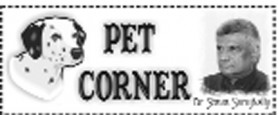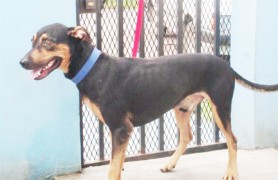
Breeds with those short (“mashed in”) faces tend to have fewer teeth – most likely because their jaws are shortened. Yet, Dobermans may have jaws in which the premolars are missing – and, as you know, they have very elongated jaws.
Once again, Biology is not as exact as, say, Mathematics. One can find, during the general examination of a canine’s mouth, that there are more teeth than there should be (“overcrowding”). This would result in the overriding of teeth and twisted teeth. The solution in this case is simply to extract the offending teeth to provide room for the rest of the teeth. Your veterinarian must make this judgement.

Since I am on this subject of abnormalities, perhaps the condition of the “unstable jaw” should be mentioned. In certain breeds, especially the “Toy Breeds”, e.g. Pekinese and the Chihuahua, there is a persistence of soft cartilage at the point where the two halves of the lower jaw (mandibula) connect up at the front (at the chin). Under normal conditions, as the dog moves from puppy to adulthood, the cartilage at this point at the front of the chin, becomes calcified into bone.
When this “unstable jaw” condition occurs, it is usually the incisors (the front teeth) which suffer. The roots of the incisors are anchored in this soft cartilage. Obviously, this anchorage is not stable and the incisors are shaky and may soon fall out. Once this has happened, the cavities left behind are a perfect breeding ground for bacteria to flourish. The cartilage itself can be consequently destroyed. This is a terrible situation, since the bones of two halves of the lower jaw – not being fused – tend to move independently of each other. The animal would therefore have difficulty eating.
The surgeon must now take over. Firstly, antibiotics have to administered to kill the destructive bacteria. At the same time, those wobbly teeth, if they have not fallen out on their own, must be removed.
Then the two halves of the lower jaw must be stabilized at the joint with screws and wires.
Hopefully, this intervention will buy some time, so that the dog can strengthen itself through the improved intake of quality food. In dogs and cats the incisors do not play such an important role. These animals just gobble the food in and after a few chews, if any, the food is swallowed.
Since the “unstable jaw” is primarily a genetic defect, such deformed animals should not be allowed to breed.
As misfortune will have it, as I was preparing this article, a dog was presented, late in the evening, with a tooth fracture. So, I have decided (within the context of discussing Oral Ailments) to share a few words pertaining to fractures and fissures of the teeth in our companion animals.
Firstly, we must remember that dogs do not really chew too much, rather they bite and swallow. So, fractures of the teeth (pre-molars and molars) at the side of the jaw (mouth) rarely happen. The hard object (e.g. stone or a piece of metal) that could cause the fracture is usually swallowed (this might result in another problem later on as the swallowed object reaches the intestinal tract). Very seldom do the incisors (front teeth) exhibit fractures and fissures.
If a fracture extends to the root of the tooth then an infection around the base of the tooth can develop (alveolar periostitis). The treatment will involve a surgical intervention (not lastly an extraction of the damaged tooth) which only your vet can undertake.
Next week we’ll deal with dental caries and tooth decay. Until then care your pets and enjoy the week.
Please implement disease preventative measures (vaccinations, routine dewormings, monthly anti-Heartworm medication, etc) and adopt-a-pet from the GSPCA’s Animal Clinic and Shelter at Robb Street and Orange Walk, if you have the wherewithal to care well for the animals. Do not stray your unwanted pets, take them to the GSPCA’s Clinic and Shelter instead. If you do not wish your pet to have puppies or kittens, you may exploit the GSPCA’s free spay and neutering programme. If you see anyone being cruel to an animal, or if you need any technical information, please get in touch with the Clinic and Shelter by calling 226-4237.





